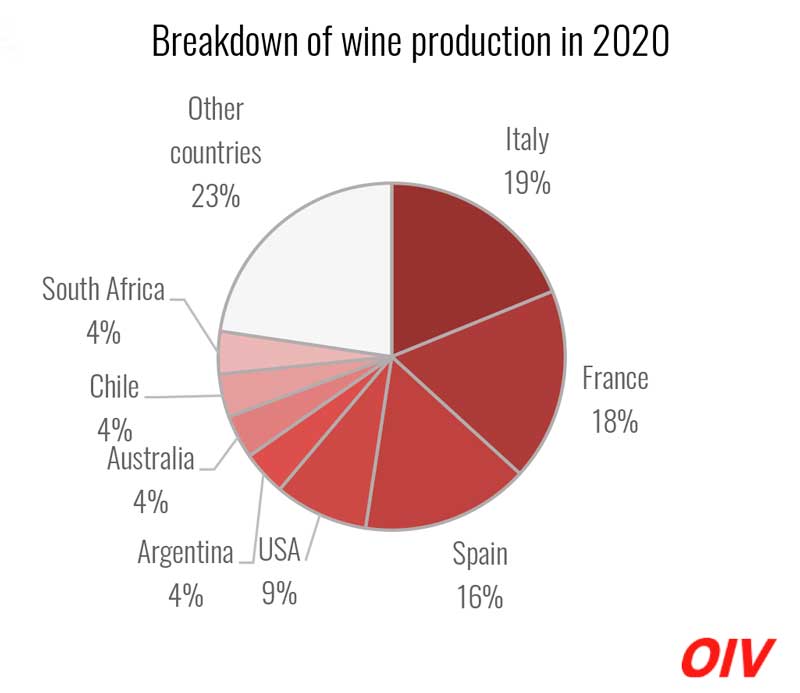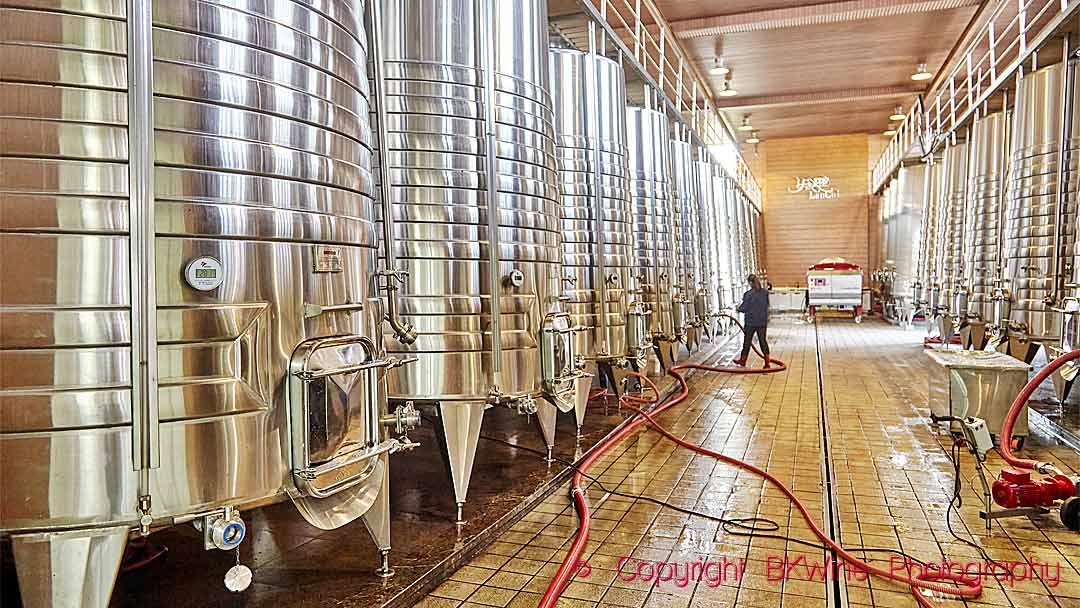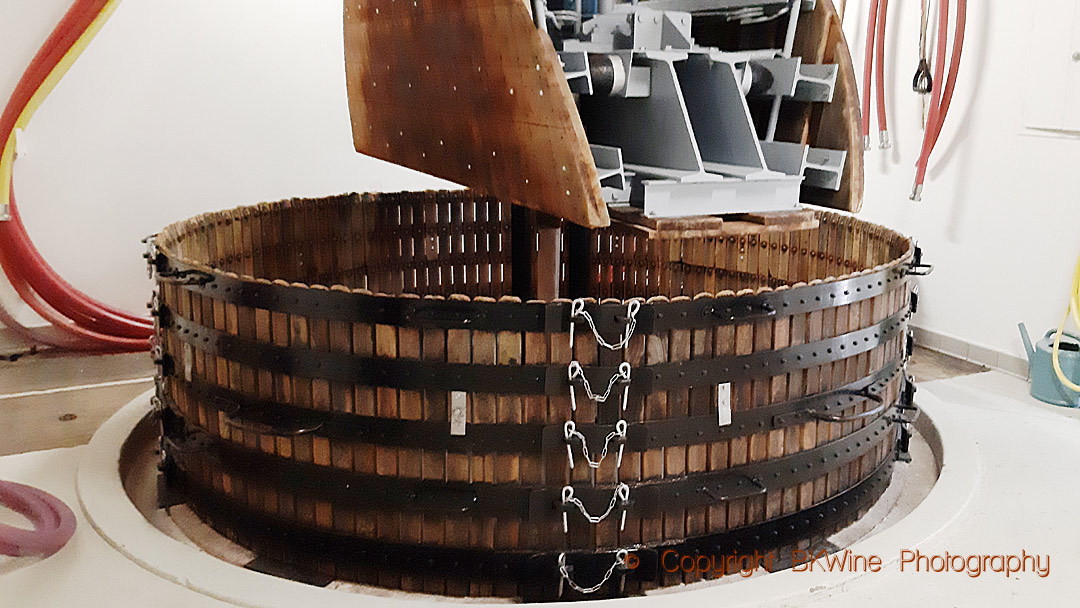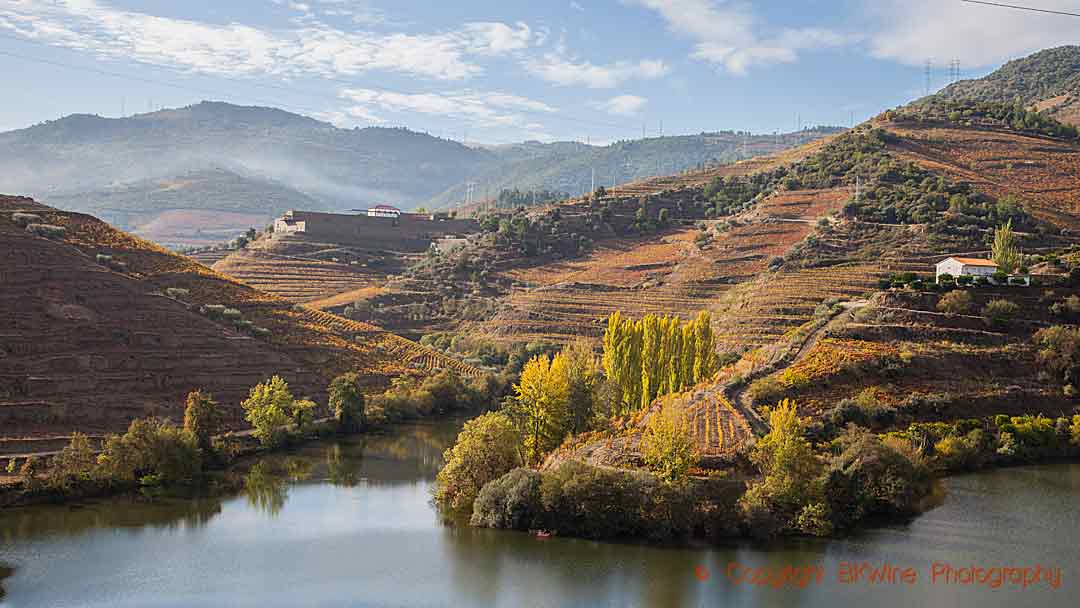In 2020 the world’s wine production increased a little to reach 260 million hectolitres. This is slightly below the long term average. Italy is still the biggest wine producing country, followed by France and Spain. The harvest was both abundant and of excellent quality in Europe but production was artificially depressed due to political reasons, but was still up. In the rest of the world many countries saw a decline in wine production, including in China.
In this article you can read about:
- Global wine production in 2020
- Wine production (juices and musts excluded) in major countries, in million hectolitre
- Wine production in the EU 2020: growth in the 3 big countries
- Eastern Europe: fall
- North America: USA declining
- South America: a small harvest
- South Africa: recovering
- Oceanian: ups and downs
- Asia: China dropping
Read all our articles in the Wine Global 2020 series here:
- Global wine production 2020
- The World’s vineyard surface 2020
- How important is wine production to a country?
- The world’s most productive wine producing countries
- World wine consumption in 2020
- Wine consumption per person in 2020
- World wine exports in 2020
- World wine imports in 2020
- Wine exports compared to total production (dependency on exports)
- Wine exports compared to GDP and to total exports
- Average price per litre on export, by country
- Exports in bottle, sparkling, bag-in-box, bulk in 2020
As a comparison, you can find preliminary numbers of wine production in 2021 here.
Data come from the OIV, the International Organisation of Vine and Wine, unless otherwise noted.
This is a longer version of an article published on Forbes.com.
Global wine production in 2020
World wine production in 2020 is estimated to have reached 260 million hectolitres (Mhl). This is an increase of 1%, almost 3 Mhl, compared to 2019. This level is just slightly below the long-term average.
Since 2000 we have had three very big years, 2004, 2013, and 2018, reaching 290-295 Mhl. The smallest production over this period was in 2017 when it was below 250 Mhl. Second smallest was 2002 that reached only 255 Mhl.
248 Mhl to 295 Mhl, that’s a variation between smallest and biggest of just over 45 Mhl, which translates to an up-and-down swing of around 8-9% around the average (each direction, so a total amplitude of ~17%). Quite a lot but that’s to a large extent the vagaries of weather. (And looking forward from 2020, 2021 will show that the drops in production due to climate can be much bigger than that.)
Italy is still the biggest wine producing country with 49.1 Mhl (+3%).
It is followed by France with 46.6 Mhl (+11%) and Spain with 40.7 Mhl (+21%).
Here are the top ten wine producing countries in the world:
| Rank | Country | Wine Production 2020 |
|---|---|---|
| 1 | Italy | 49.1 Mhl |
| 2 | France | 46.6 Mhl |
| 3 | Spain | 40.7 Mhl |
| 4 | USA # | 22.8 Mhl |
| 5 | Argentina | 10.8 Mhl |
| 6 | Australia | 10.6 Mhl |
| 7 | South Africa | 10.4 Mhl |
| 8 | Chile | 10.3 Mhl |
| 9 | Germany | 8.4 Mhl |
| 10 | China # | 6.6 Mhl |
# = OIV estimate
The three stable leaders
The top three slots are solidly in the hands of Italy, France and Spain.
Italy and France used to take turns being number one, but in recent years Italy has kept a firm grip on the top spot. These two are followed by Spain with a comfortable margin, at least for the moment. (Again, see the preliminary figures for 2021, reported here, that will show you that nothing is safe.)
The perpetual #4
Number four is the USA. It is far below the number three (Spain). The Spanish production is almost double that of the USA. But the US is also far ahead of the nearest competitor below, with more than twice the volume of the number five.
The New World cluster: 5,6,7,8 (and 9)
In slot 5, 6, 7, 8 we have a group of New World countries that are very close together: Argentina, Australia, South Africa and Chile, all with a little bit over 10 Mhl of production in 2020. The order of these four varies from year to year. Occasionally Germany squeezes into this group. China also did a brief appearance in this group a few years back.
Usually, Germany is a fair distance below this group of four.
The volatile wildcard
China is in 10th place in 2020. In 2016 it was number 5 in the ranking but production has steadily declined since then and now, with only 6.6 Mhl, it is far behind Germany. But it being a volatile country it is hard to predict what will happen in the future.
Wine production (juices and musts excluded) in major countries, in million hectolitre
The world’s 19 biggest wine-producing countries:
| rank ’20 | Country | 2020 prel. | 20/’19 % var. | % of WW total | cumul. | 2019 prov. | 2018 | 2017 | 2016 |
|---|---|---|---|---|---|---|---|---|---|
| 1 | Italy | 49.1 | 3% | 19% | 19% | 47.5 | 54.8 | 42.5 | 50.9 |
| 2 | France | 46.6 | 11% | 18% | 37% | 42.2 | 49.2 | 36.4 | 45.4 |
| 3 | Spain | 40.7 | 21% | 16% | 52% | 33.7 | 44.9 | 32.5 | 39.7 |
| 4 | USA # | 22.8 | -11% | 9% | 61% | 25.6 | 26.1 | 24.5 | 24.9 |
| 5 | Argentina | 10.8 | -17% | 4% | 65% | 13 | 14.5 | 11.8 | 9.4 |
| 6 | Australia | 10.6 | -11% | 4% | 69% | 12 | 12.7 | 13.7 | 13.1 |
| 7 | South Africa | 10.4 | 7% | 4% | 73% | 9.7 | 9.5 | 10.8 | 10.5 |
| 8 | Chile | 10.3 | -13% | 4% | 77% | 11.9 | 12.9 | 9.5 | 10.1 |
| 9 | Germany | 8.4 | 2% | 3% | 81% | 8.2 | 10.3 | 7.5 | 9 |
| 10 | China # | 6.6 | -16% | 3% | 83% | 7.8 | 9.3 | 11.6 | 13.2 |
| 11 | Portugal | 6.4 | -2% | 2% | 86% | 6.5 | 6.1 | 6.7 | 6 |
| 12 | Russia | 4.4 | -4% | 2% | 87% | 4.6 | 4.3 | 4.5 | 5.2 |
| 13 | Romania | 3.6 | -7% | 1% | 89% | 3.8 | 5.1 | 4.3 | 3.3 |
| 14 | New Zealand | 3.3 | 11% | 1% | 90% | 3 | 3 | 2.9 | 3.1 |
| 15 | Hungary | 2.4 | -12% | 1% | 91% | 2.7 | 3.6 | 2.5 | 2.5 |
| 16 | Austria | 2.4 | -3% | 1% | 92% | 2.5 | 2.8 | 2.5 | 2 |
| 17 | Greece | 2.3 | -6% | 1% | 93% | 2.4 | 2.2 | 2.6 | 2.5 |
| 18 | Brazil | 1.9 | -5% | 1% | 93% | 2 | 3.1 | 3.6 | 1.3 |
| 19 | Georgia | 1.8 | 2% | 1% | 94% | 1.8 | 1.7 | 1 | 0.9 |
| X1 | Other countries | 15.4 | -7% | 6% | 100% | 16.6 | 18.1 | 16.5 | 16.8 |
| X2 | World total | 260 | 1% | 100% | 258 | 294 | 248 | 270 |
# = OIV estimate
Wine production in the EU, 2020: growth in the 3 big countries
Wine production in the European Union (EU) reached 165 Mhl in 2020, a fairly substantial increase of 8% (+12 Mhl) compared to 2019. This means that the EU produces 63% of all wine in the world.
In 2013 we looked at the trend of world wine production (as represented by the 11 biggest producing countries). In 2000, the EU countries made 71% of the world wine production. In 2012, the EU had 60% of world production. Based on the trends, I did at the time a back-of-the-envelope calculation that predicted that in 2020 the EU would represent only 57% of world wine production and that by 2030 the Rest-of-the-World would overtake the EU in wine production. This prediction has now been proved wrong. The trend of steadily declining wine production in the EU has apparently been broken.
Wine production in Europe, compared to other countries, has not continued to decline as it did in the period 2000-2012. That may well have to do with that at that time the EU had a very repressive regulation with “planting rights” that made it difficult to plant new vineyards. This was supposed to be removed in the EU agricultural reform but lobbying from the big established wine lobby resulted in that the planting rights system was not abolished but transformed into a slightly more liberal “planting authorisations” system that allows for a one-percent growth of the acreage annually.
But back to wine production in 2020:
The disastrous political market manipulations in 2020 with catastrophic results
2020 was in some ways a frustrating or conflicting year for wine producers in Europe. Some of the organisations that govern the wine sector (the so-called producers’ associations; consortizo, committé interprofessionel, consejo regulador etc) made the analysis that the markets were weak, demand looked to be declining. This led them to trying to restrict the production volumes (as the OIV also notes) in order to try to keep prices high, or avoid a drop in prices; not only trying but also succeeding in restricting production. A kind of market manipulation similar to what the OPEC cartel does for petroleum. That’s the kind of market manipulation that is sometimes tried in (mainly) European wine regions.
This effort to restrict output to push prices up was to some extent successful. The permitted maximum yields were dramatically reduced in some regions. This was widely reported and happened in, for example, Champagne, but also in other wine regions in France, Spain and Italy.
For a wine producer this must have been quite frustrating – 2020 was in many regions a year of both of excellent quality and of abundant quantity thanks to generally good weather. But good fruit had to be “dropped”, left on the ground to rot, to follow the restrictive yield regulations. (This is also a good illustration of the fallacy of the “big harvest means poor quality” received wisdom.)
In hindsight, this looks to have been a very bad idea. Now aafter the end of 2021 and in early 2022, we know that the wine production in 2021 has dropped to a historical low in the big wine producing countries in Europe.
It must be heart-breaking for some producers to know that they could have made much more wine – of excellent quality – in 2020 which could have compensated for the disastrous harvest in 2021 (see more here in our preliminary article on the 2021 wine production numbers). But that is the result of the efforts to “market fixing” (reducing output to keep prices high) in some regions in 2020.
The end result, according to the OIV analysis, is that the production volume in 2020 was reduced compared to what it could have been, but not as much as was initially feared.
France, Italy and Spain represent the overwhelming majority of wine production in Europe, and 53% of all wine in the world. So how was 2020 in those countries?
- Italy 49.1 Mhl, +3% compared to 2019
- France 46.6 Mhl, +11%
- Spain 40.7 Mhl, +21%
Italy is the world’s biggest wine producer once again in 2020. It produced 49.1 Mhl, which is an increase of 3% (1.6 Mhl) compared to 2019, which was, however, a small harvest.
This is in line with the five year average, while compared to the very large harvest of 2018 it is -13% (7.3 Mhl).
France, the world’s second largest wine producer, made 46.6 Mhl, which is an increase of 11% (4.4 Mhl) compared to 2019.
This is 6% above the five year average, but 15% (7.1 Mhl) less than the abundant 2018.
Spain, number 3, had a production of 40.7 Mhl, an increase of 21% (!), 7 Mhl, from 2019.
This is 8% above the five year average, but a whopping 25% less than 2018, -11.4 Mhl.
Italy, France and Spain together made 136 Mhl which was an increase with 10.5%. They represent a smidget more than half of the world’s wine production (53%)
The rest of the EU saw declining volumes in 2020, except for Germany:
- Germany 8.4 Mhl, +2% compared to 2019
- Portugal 6.4 Mhl, -2%
- Romania 3.6 Mhl, -7%
- Austria 2.4 Mhl, -3%
- Hungary 2.4 Mhl, -12%
- Greece 2.3 Mhl, -6%
Eastern Europe: fall
There was an overall decline in wine production in Eastern Europe (excluding EU countries) with the exception of Georgia:
- Russia 4.4 Mhl, -4%
- Georgia 1.8 Mhl, +2%
- Ukraine 0.7 Mhl, -33% (!)
- Moldova 0.9 Mhl, -37% (!)
North America: USA declining
The USA produced 22.8 Mhl of wine in 2020 making it the world’s fourth largest wine producer. It is a decline, -11%.
There are two main reasons given for the shrinking production:
California had a difficult year (again) with hot weather and big wildfires in some of the winegrowing regions. This affected the harvest in two ways: Yields were lower in some areas and smoke-tainted grapes were sometimes discarded.
The other cause is that there is, according to the OIV, an over-supply of grapes and wine in the US.
South America: a small harvest
The three biggest wine producing countries in South America saw a decline in production:
- Argentina 10.8 Mhl, -17%
- Chile 10.3 Mhl, -13%
- Brazil 1.9 Mhl, -5%
The small harvests are attributed to bad weather caused by El Niño. Argentina is nevertheless the world’s 5th biggest wine producer in 2020 and Chile is number eight.
South Africa: recovering
Wine production in South Africa reached 10.4 Mhl in 2020, up 7%. It is well on its way to recovering after three years of severe drought (2016-2018). This brings South Africa to position 7 in the ranking, overtaking Chile.
It remains to be seen if the policies periodically introduced during the current pandemic, with e.g. total bans on alcohol sales, will have a longer term negative effect – if it may cause some producers to go out of business.
Oceanian: ups and downs
Australia reached 10.6 Mhl, -11%, giving it position 6 in the ranking, a tight race with Argentina and South Africa. It is the third year in a row with a decline.
New Zealand, on the other hand, did well and reached 3.3 Mhl, up +11%. This is on par with its biggest harvest ever. But in spite of the growing production, New Zealand is a quite small wine producing country, between Romania and Hungary in the world ranking.
Asia: China dropping
The only country in Asia with a significant wine production is China. It saw a drop to 6.6 Mhl, -16%. This places China as number ten in the list of the world’s biggest wine producing nations.
It is the fourth year in a row that production in China has declined. In 2016 it was the world’s 5th biggest wine producer with 13.2 Mhl. Chinese wine production has been cut in half since then.
The OIV speculates that this can be due to “structural” problems, e.g. difficult climate conditions, technological constraints (whatever that means; supply problems with equipment or planting material?) and overall low productivity. Another hypothesis is that domestic wine is being replaced by cheaper imported wines. Will this be affected by the current wine trade war between China and Australia in the future?
It should also be noted that Chinese wine statistics is known to be not totally reliable (“is revised frequently and must be treated with caution”).
All data comes from the OIV unless otherwise specified. All comments and opinions are BKWine’s.
Travel
Why not take a close look yourself on the wine production in the world? You can come on a wine tour with BKWine to some of the worlds wine regions that will give you insight into wine growing and wine production.
Travel to the world’s wine regions with the wine experts and the wine travel specialist.
Wine tours that give you insight. BKWine wine tours.
















